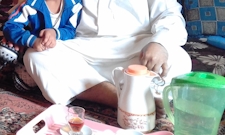
Expert analysis
20 June 2018
Between a rock and a hard place
In our Invisible Majority thematic series, we set out to better understand the relationship between internal displacement and cross-border movements. Preliminary findings show that high numbers of refugees have previously experienced internal displacement, and that difficult conditions in host countries may be forcing some refugees to return prematurely to their country of origin, despite the risk of further displacement.
The number of people forcibly displaced by violence worldwide has reached a record high, according to UNHCR’s annual Global Trends report released for World Refugee Day. By the end of 2017, 40 million people were internally displaced within the boundaries of their own countries – nearly double the world’s 25 million refugees. In the absence of durable solutions to their displacement, it is almost inevitable that some of these IDPs will eventually seek refuge abroad.
Of the 178 Iraqi refugees interviewed in Jordan and Sweden for this thematic series, over half had been internally displaced before leaving Iraq. Our previous blog post in May discussed the complex journeys undertaken by the refugees we encountered in Sweden. Iraqis in Jordan shared similar stories.
Samer* and his family, originally from Ramadi, were forced to flee from neighbourhood to neighbourhood as ISIS advanced throughout the city. When the city fell, they moved to Sulaymaniyah in Iraqi Kurdistan. Although Sulaymaniyah was comparatively safe, the widespread use of the Kurdish language hindered their children’s education. The family decided to leave the country, eventually settling in Jordan.
Akram* from Baghdad escaped to his sister’s home in Qaraqosh after being threatened by a local armed group. However, Qaraqosh was soon captured by ISIS, and Akram made the decision to return to Baghdad to seek refuge at his former place of employment. Despite his efforts to hide, the armed group found him again, and he was forced to flee to Jordan.
Afraid for their safety, neither Akram nor Samer wish to return to Iraq. Overall, only 3% of the refugees interviewed in Jordan and Sweden want to return to live in Iraq, with an additional 11% reporting that they ‘maybe’ want to return. The majority of refugees perceive Iraq to be very unsafe: 76% of respondents scored security in Iraq only 1 out of 10. Despite this, limited opportunities to earn a decent wage in their host country are pushing some refugees to return - even in the face of continued insecurity. In Jordan, Iraqi refugees are unable to work and, in Sweden, our research revealed that refugees who are finding it difficult or impossible to survive on their current income are much more likely to be contemplating returning to Iraq. They are caught “between a rock and a hard place”, as one interviewee explained.
Such returns are fundamentally unsustainable. Refugees returning from situations of vulnerability in their host countries are likely to experience similar vulnerabilities in their countries of origin, exacerbated by ongoing instability and heightened protection concerns. With their physical security at risk and few options to earn a living, there is a strong likelihood that these returning refugees will find themselves further displaced.
In practice, this means that hosting states should ensure that refugees have access to assistance and job opportunities to prevent premature returns from contributing to vicious cycles of displacement, both internal and cross-border. Cynical voices may argue that it is in the interest of certain host states to encourage rapid return – but if premature returns lead to further internal displacement, and internal displacement leads to further cross-border movements, it is clear that this approach is no solution to global refugee crises.
If the international community really aspires to prevent and resolve displacement crises, it should start by tackling the root causes of conflict and violence within countries of origin. Akram and Samer would probably not have become refugees if the root causes of their displacement had been addressed in Iraq. If they do return to Iraq in the future, they are going to need support to rebuild their lives; policy and programming for durable solutions should include not only IDPs but also returning refugees.
Our upcoming research among returned refugees and IDPs in Iraq will provide more evidence to support these findings, shining further light on the relationship between internal displacement and cross-border movements. How many IDPs aspire to cross borders? How many returning refugees are further displaced? Look out for our next blog post to find out more.
(*All names have been changed to protect identities.)